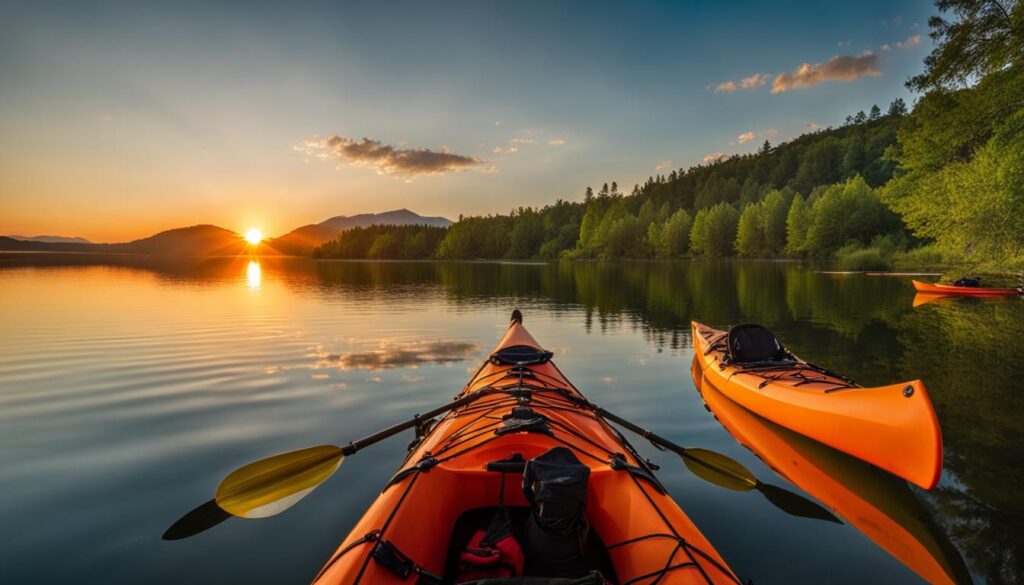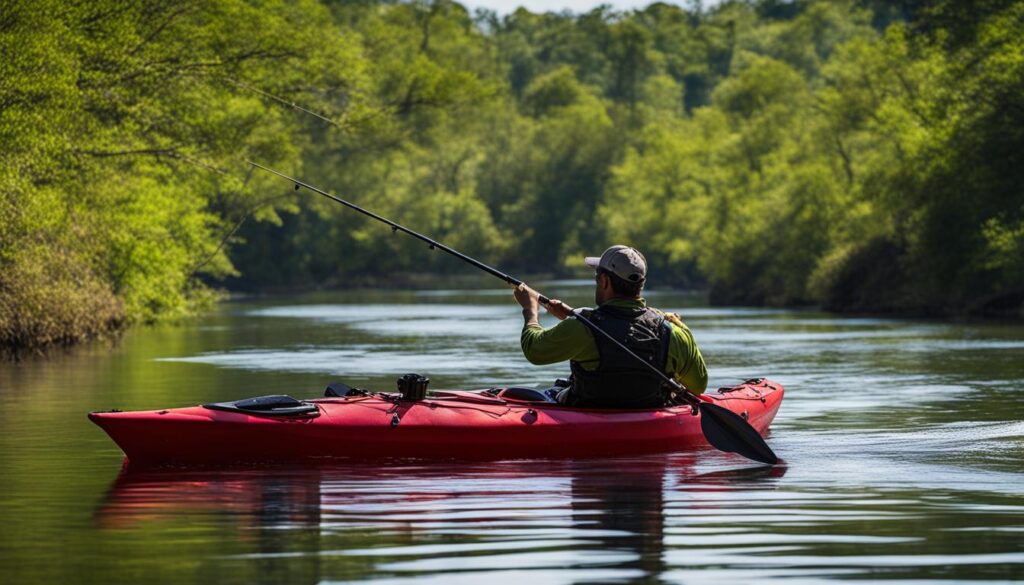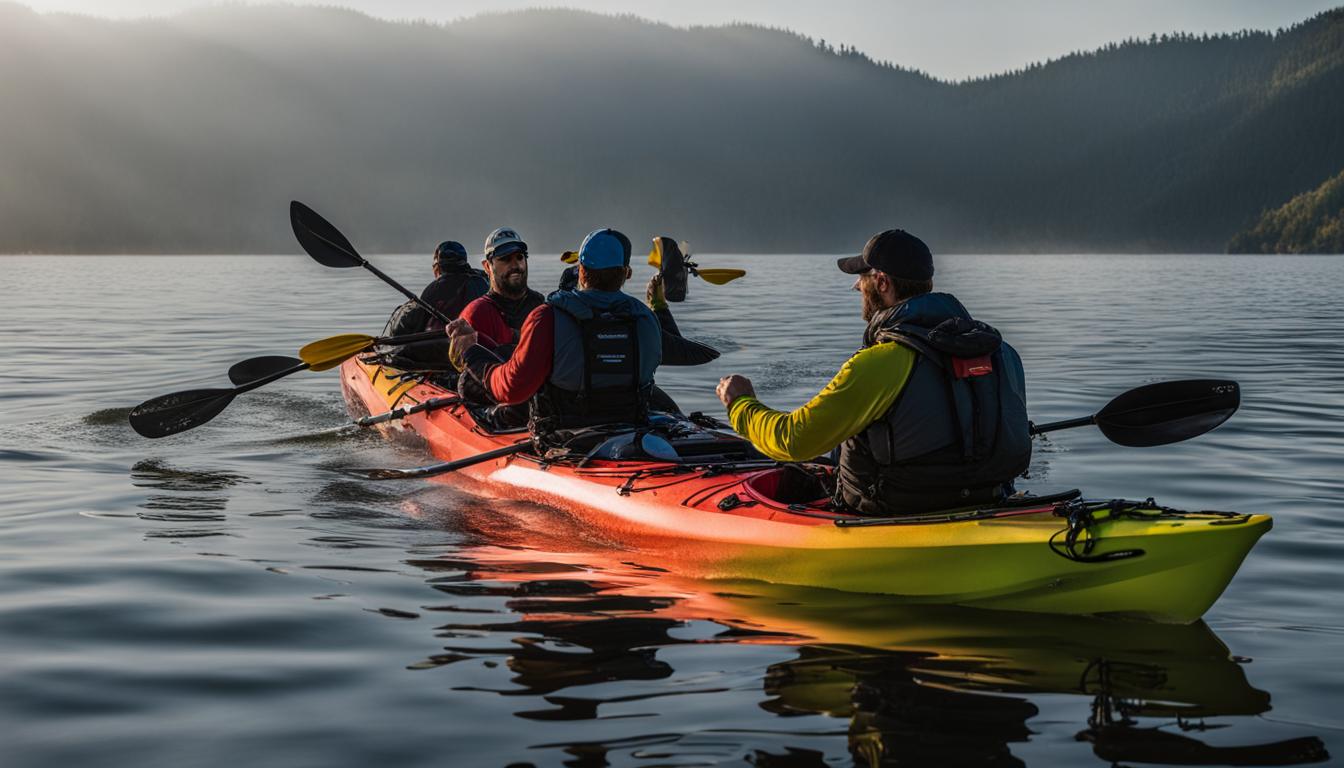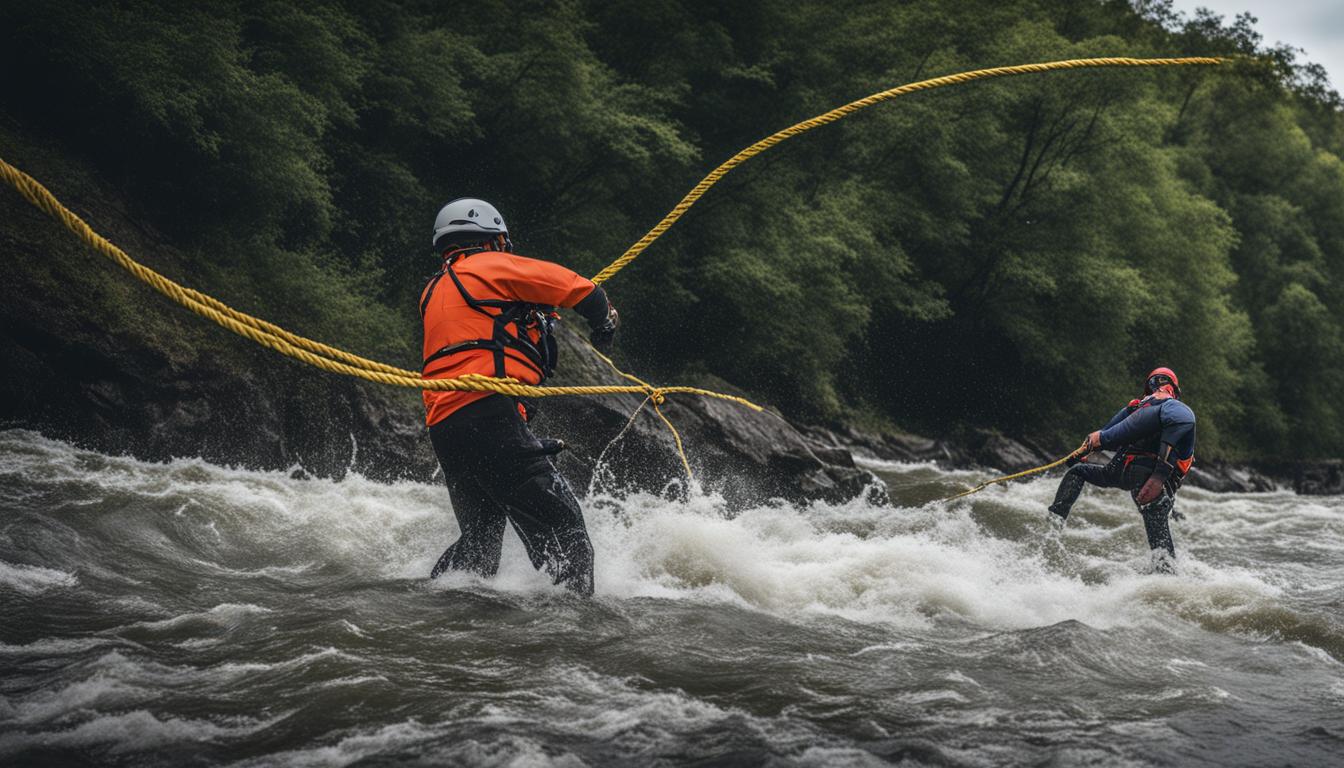Kayak fishing is a thrilling and rewarding experience that allows you to explore diverse fishing spots and get up close and personal with nature. To make the most out of your kayak fishing trips, it’s important to understand the prime times for angling. By planning your fishing adventures during the ideal hours, you can significantly increase your chances of a successful catch. In this section, we’ll explore the best times for kayak fishing and how to maximize your catch potential.
Key Takeaways:
- Choosing the right timing is crucial for a successful kayak fishing trip.
- Night fishing around lighted areas can be highly productive.
- Fish behavior at night is different from daytime, making it a prime time to catch trophy fish.
- Proper kayak night fishing gear and safety precautions are essential.
- Docks, bridges, and inlets are great spots for kayak fishing during specific time periods.
Kayak Fishing: A Unique Angling Experience
Kayak fishing offers anglers a unique and exhilarating experience. Fishing from a kayak allows access to different bodies of water, including freshwater ponds, lakes, streams, and saltwater coastlines and inlets. It provides an opportunity to explore remote fishing holes that may be unreachable by larger boats.
One of the advantages of kayak fishing is the economy and environmental friendliness it offers. Kayaks are more cost-effective than boats, and they don’t burn fuel, reducing the carbon footprint. The quietness and stealth of kayaks allow for a more intimate fishing experience, as fish are less likely to be scared away by loud noises. Kayaks also offer new fishing angles, as their lower vantage point allows for casting under docks and between fallen trees. Additionally, kayaks are convenient to transport and customize with various fishing accessories.
By choosing the right kayak, equipping yourself with the essential gear, and mastering proper techniques, you can maximize your catch potential and make the most out of your kayak fishing adventure.
Why Choose Kayak Fishing?
- Access to various bodies of water: Kayak fishing allows you to explore freshwater and saltwater fishing spots that may be inaccessible to larger boats.
- Economy and environmental friendliness: Kayaks are more affordable and eco-friendly compared to motorized boats, offering a cost-effective and sustainable fishing experience.
- Stealth and quietness: The quiet nature of kayaks allows for a more intimate fishing experience, as fish are less likely to be spooked by loud noises.
- Enhanced fishing angles: Kayaks provide a lower vantage point, enabling anglers to cast under docks and between tight spaces, increasing the chances of a successful catch.
- Convenient transportation and customization: Kayaks are easy to transport and can be customized with fishing accessories according to individual preferences and needs.
By embracing kayak fishing, anglers can enjoy the thrill of exploring new fishing locations, while also benefiting from its economic and eco-friendly nature. The unique advantages of kayaks, such as their stealth and low vantage point, open up opportunities for successful catches. With the right equipment and techniques, kayak fishing can provide an unforgettable angling experience.
Kayak Fishing: A Unique Angling Experience
Kayak fishing offers anglers a unique and exhilarating experience. Fishing from a kayak allows access to different bodies of water, including freshwater ponds, lakes, streams, and saltwater coastlines and inlets. It provides an opportunity to explore remote fishing holes that may be unreachable by larger boats. One of the advantages of kayak fishing is the economy and environmental friendliness it offers. Kayaks are more cost-effective than boats, and they don’t burn fuel, reducing the carbon footprint. The quietness and stealth of kayaks allow for a more intimate fishing experience, as fish are less likely to be scared away by loud noises. Kayaks also offer new fishing angles, as their lower vantage point allows for casting under docks and between fallen trees. Additionally, kayaks are convenient to transport and customize with various fishing accessories. By choosing the right kayak, equipping yourself with the essential gear, and mastering proper techniques, you can maximize your catch potential and make the most out of your kayak fishing adventure.
Kayak Fishing Time Planning
When it comes to kayak fishing, strategic timing is crucial for a successful fishing trip. Understanding the best times to fish can significantly increase your chances of landing a trophy catch. Factors such as weather conditions, tides, and the behavior of the targeted fish species all play a role in determining the optimal fishing time. In general, the early morning and late afternoon tend to be the most productive times for kayak fishing. During these periods, fish are often more active, feeding near the surface and searching for prey. The calmness and serenity of the early morning also make it an ideal time to enjoy the tranquility of nature while waiting for the fish to bite. However, it’s essential to note that fishing conditions can vary depending on the location and season. For example, some fish species are more active during specific seasons, such as spawning periods or migration times. Researching local fishing reports, consulting with experienced anglers, and experimenting with different times of the day can help you determine the most effective fishing times in your area.
| Fishing Time | Advantages | Disadvantages |
|---|---|---|
| Early Morning | – Fish are usually more active, searching for food near the surface. | – Cooler temperatures might require warmer clothing. |
| Late Afternoon | – Similar to the early morning, fish are often more active and feeding. | – Depending on the location, it may be easier to encounter boat traffic during this time. |
| Night Fishing | – Some fish species, like snook and redfish, are more active and accessible at night. | – Requires extra safety precautions, such as proper lighting and navigation equipment. |
By understanding the best kayak fishing times and planning your trips accordingly, you’ll have a higher chance of success on the water. Remember to check local regulations, be mindful of your safety, and respect the environment while enjoying your kayak fishing adventures.

Essential Gear and Equipment for Kayak Fishing
Equipping yourself with the right gear and equipment is crucial for a successful kayak fishing trip. In addition to your Hobie kayak, there are several essentials to consider.
1. Fishing Rods and Reels: Choose a rod and reel combo that suits your fishing style and the type of fish you plan to target. Consider the length, action, and power of the rod, as well as the gear ratio of the reel.
2. Tackle Box: Fill your tackle box with a variety of lures and bait to attract different fish species. Include options for both freshwater and saltwater fishing, and carry extras in case you lose or damage any tackle during your trip.
3. Life Jacket: Safety should always be a priority when kayak fishing. Invest in a comfortable and properly fitting life jacket to ensure your safety on the water. Look for a Coast Guard-approved PFD that provides maximum buoyancy and has convenient features like pockets for storage.
Kayak Fishing Gear Checklist:
- Fishing rods and reels
- Tackle box with lures and bait
- Life jacket or personal flotation device (PFD)
- Polarized sunglasses
- Waterproof bag
- Fish finder
- Rod holders
- Paddle and rod leashes
- Tackle crate for organization
4. Polarized Sunglasses: Invest in a good pair of polarized sunglasses to reduce glare and improve visibility on the water. Polarized lenses help you see beneath the surface of the water, making it easier to spot fish and underwater structures.
5. Waterproof Bag: Protect your belongings, including your phone, wallet, and extra clothing, by keeping them in a waterproof bag. This will prevent them from getting wet in case of any water splashes or kayak overturns.
Having the right gear will not only enhance your fishing experience but also increase your chances of a successful catch. Be sure to check local regulations and obtain the necessary fishing licenses before heading out on your kayak fishing adventure.
Table: Comparison of Popular Kayak Fishing Gear Brands
| Brand | Fishing Rods | Reels | Tackle Boxes |
|---|---|---|---|
| Hobie | High-quality rods suitable for various fishing styles | Premium reels with smooth drag systems | Spacious tackle boxes with multiple compartments |
| Shimano | Durable and sensitive rods for different fishing techniques | Reliable reels known for their smooth performance | Well-designed tackle boxes with ample storage space |
| Okuma | Affordable rods with a good balance of performance and durability | Quality reels suitable for various fishing applications | Compact tackle boxes with secure latches |
Mastering Kayak Fishing Techniques
To maximize your chances of a successful catch during your kayak fishing trips, it’s important to master proper techniques. Whether you’re a beginner or a seasoned angler, honing your skills can make a significant difference in your fishing success. Here are some key techniques to consider:
1. Casting with Precision
Casting from a seated position in a kayak requires practice and precision. It’s important to maintain a stable posture and utilize smooth, controlled movements when casting. Take into account the wind and water conditions to adjust your casting technique accordingly. Practice casting in different directions and distances to improve your accuracy.
2. Handling and Releasing Fish
Properly handling and releasing fish from your kayak is essential for their well-being and the preservation of the ecosystem. Use a landing net to safely bring the fish on board, keeping it in the water as much as possible. Use a fish grip or wet your hands before handling the fish to prevent damaging their protective slime coating. When releasing the fish, gently lower it back into the water and ensure it has fully recovered before letting go.
3. Adapting to Different Conditions
As an angler, you’ll encounter various conditions on the water, such as wind, currents, and tides. It’s important to adapt your techniques accordingly. For example, when dealing with strong winds, you may need to adjust your paddling and casting angles to maintain control and accuracy. Understanding how these factors affect fish behavior and adjusting your approach accordingly can greatly increase your chances of a successful catch.
Remember, practice is key to mastering these techniques. Spend time on the water, experiment with different approaches, and learn from your experiences. The more you practice, the better you’ll become at adapting to different situations and maximizing your catch potential.

Now that you’re familiar with these kayak fishing techniques, it’s time to put them into practice. As you continue to refine your skills, you’ll become a more skilled and successful kayak angler. So grab your kayak, gear up, and head out on your next adventure, confident in your ability to master the art of kayak fishing.
Finding the Best Fishing Spots for Kayak Anglers
When it comes to kayak fishing, finding the best fishing spots can significantly increase your chances of a successful catch. Kayaks provide access to remote and hard-to-reach areas that may hold abundant fish populations. To maximize your fishing experience, it’s essential to do some research and planning.
One effective way to identify potential hotspots is by studying maps, both online and offline. Look for areas such as points, reefs, and drop-offs that are likely to attract fish. Pay attention to structures like submerged logs or rock formations, as they often serve as hideouts for fish.
It’s also important to consider factors such as tidal patterns, currents, and wind direction. These elements can influence fish behavior and indicate productive fishing areas. By understanding the movements of the water and adapting your fishing strategy accordingly, you can significantly increase your chances of success.
| Fishing Spot | Location | Best Seasons |
|---|---|---|
| Coastal Inlets | Nearshore areas with inlets | Spring and Fall |
| Marshes and Estuaries | Shallow, brackish waters | Summer and Winter |
| Rocky Shorelines | Areas with submerged rocks | All year round |
| Freshwater Lakes | Inland lakes and reservoirs | Spring and Summer |
Another valuable resource is online fishing forums and local angler communities. Joining these communities allows you to tap into the experience and knowledge of fellow anglers who are familiar with the area. They can provide valuable insights and recommendations for the best fishing spots in your region.
By planning your kayak fishing trips strategically and understanding where to find the fish, you’ll significantly increase your chances of a successful catch. Remember to always prioritize safety and respect the environment while enjoying your angling adventures.
Conclusion
Kayak fishing offers you a unique and rewarding experience, allowing you to explore remote fishing spots and enjoy the tranquility of nature. By understanding the effective timing for kayak fishing, you can increase your chances of a successful catch.
Choosing the right Hobie kayak is crucial to ensure a comfortable and enjoyable fishing trip. Equipping yourself with the essential gear and equipment, such as fishing rods, tackle boxes, and life jackets, will help you make the most of your fishing experience.
Mastering proper kayak fishing techniques, such as casting and releasing fish, will make you a skilled angler. By finding the best fishing spots, whether it’s through online research, local knowledge, or observing tidal patterns, you’ll increase your chances of landing that trophy fish.
Remember, safety should always be your top priority. Take good care of your kayak and follow safety guidelines to ensure a secure and enjoyable adventure. With careful planning and preparation, you can fully immerse yourself in the exciting world of kayak fishing and create lasting memories on the water.
FAQ
What are the best times for kayak fishing?
Kayak fishing can be productive at different times, but some prime times include early morning and evening when fish are more active. Night fishing can also be highly productive, especially around lighted areas.
Why is night fishing beneficial for kayak anglers?
Night fishing offers a relaxed and less spooky environment for fish, increasing the chances of a successful catch. Lights from docks, bridges, and lighted sea walls attract baitfish and larger predators, making it a prime time to catch trophy fish.
What safety gear is essential for kayak fishing at night?
Essential safety gear for night fishing includes a whistle, life vest, and a white light for navigation. It’s important to prioritize safety and be prepared for any unforeseen situations.
What are some good spots to target specific fish at night?
Docks with larger boats moored to them are great spots to target snook and redfish at night. Bridges are ideal for fishing monster snook. Inlets and deep channels are also productive, especially with the use of Flair Hawk jigs and live baits like pilchards and shrimp.
What are the advantages of kayak fishing compared to other methods?
Kayak fishing allows access to different bodies of water, including remote fishing holes that may be unreachable by larger boats. It offers cost-effectiveness, environmental friendliness, and a quiet and stealthy approach, increasing the chances of a successful catch.
What gear and equipment do I need for kayak fishing?
Essential gear includes fishing rods and reels, a tackle box with a variety of lures and bait, a life jacket, polarized sunglasses, and a waterproof bag. Accessories like rod holders, paddle and rod leashes, and a tackle crate can enhance your fishing experience.
What techniques should I master for kayak fishing?
Proper casting techniques from a seated position, handling and releasing fish from your kayak, and adjusting your technique based on wind and water conditions are important skills to master. Practicing and refining these techniques will increase your catch rates.
How can I find the best fishing spots for kayak angling?
Researching maps, both online and offline, can help identify potential hotspots like points, reefs, and drop-offs. Paying attention to tidal patterns, currents, and wind direction, and consulting with local anglers can also provide valuable insights into productive fishing areas.





